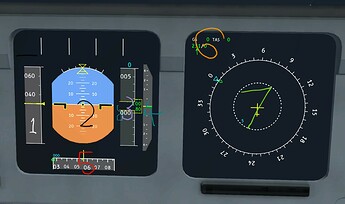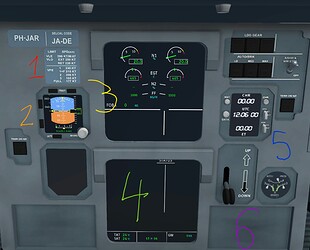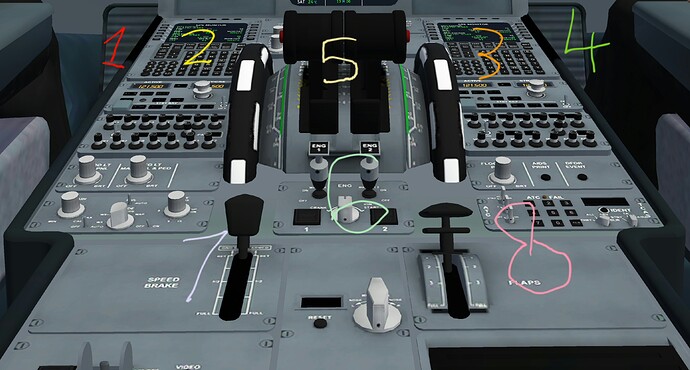The A320 is one of the most popular jet airliners ever built, and as a result, it is featured in almost every flight simulator on the market. In this tutorial you will find the plane’s flying guide and performance characteristics. I hope you will find it useful!
The A320ceo Family - A Technical Overview
| Measurement | A318 | A319 | A320 | A321 |
|---|---|---|---|---|
| Length | 31.44m | 33.84m | 37.57m | 44.51m |
| Wingspan | 34.10m | 35.80m | 35.80m | 35.80m |
| Aircraft height | 12.56m | 11.76m | 11.76m | 11.76m |
| Fuselage Width | all 3.95m | |||
| MTOW | 68t | 75.5t | 78t | 93.5t |
| MLW | 57.50t | 62.50t | 66t | 77.80t |
| Typical Cruise Speed | all M. 78 | |||
| MMO | all M. 82 | |||
| Service Ceiling | all 39100-41000ft | |||
| Engines | *PW6000/CFM56-5B | all others IAE V2500-A5/CFM56-5B | ||
| Thrust | 96-106kN | 98-120kN | 98-120kN | 133-147kN |
| Range | 3100nmi | 3750nmi | 3300nmi | 3200nmi |
*There is no PW6000 in Infinite Flight’s A318.
Cockpit Guide
The A320 has a relatively easy-to-understand cockpit, so I believe this tutorial will cover the essential aspects of the flight deck which are essential for flying.
1. PFD/ND
*PFD - Primary Flight Display
*ND - Navigation Display
PFD:
-
Indicated Airspeed/IAS indicator. The instrument that measures IAS, the speed you rely on for take-off, landing etc (as opposed to Mach, Ground speed and TAS).
-
Attitude indicator. Shows how much up/down you’re pitching or how far left/right the plane is banked. Banking beyond 35° and pitching up/down 20/10° is not recommended. In real life the Airbus flight computer limits pitch to a maximum of 30° up and 15° down.
-
Altimeter. Measures your altitude MSL.
-
VSI - Vertical Speed indicator. Measured in +/-fpm (ft per minute), a VS of -1000fpm will make the plane descend 1000ft each minute. During normal approaches (3° glide slope) a descent rate of over -1000fpm is unfavourable.
-
Heading Indicator - shows the current magnetic heading (relative to North 000°) of the plane.
ND panel:
- Ground Speed, True Airspeed and Wind Indicator
- Ground speed - the speed of the plane moving over ground.
- True airspeed - basically the speed of a plane calculated relative to the surrounding air.
- Wind Indicator - a display where data of the current wind outside the aircraft is shown (heading and speed).
- The ND: shows all waypoint and navigation information (eg TOD, ILS course pointer, LNAV/GPS). The outer ring also shows the heading, but in increments of 30° between each number.
Autopilot panel. For now, there are no mode indicator lights for the A320 AP (unless it gets reworked again later on.)
SPD - speed, IAS below FL280. Above that it will switch to Mach speed and whatever you do, fly it below the MMO.
HDG - Heading. Direction in degrees relative to magnetic north.
ALT - altitude MSL.
VS - vertical speed (fpm).
Centre Panel Display - EICAS, ECAM etc
*EICAS - Engine-indicating and crew-alerting system
*ECAM - Electronic centralised aircraft monitor
-
Flap speeds placard. It displays the maximum speeds of different stages of flap extension.
-
Backup attitude indicator. When flying in real life, if the main PFD fails pilots have to refer to this one.
-
ECAM/engines display. In real life this part is usually used to show engine data and ECAM messages at the bottom (of the section).
-
This is supposed to be the EICAS (which provides engine data but with temperature and weight in the same box) in real world flying but that is not modeled in the IF A320. In IF that is used to show the aircraft weight and temperature only.
-
Clock, middle number is UTC time.
-
Landing gear lever.
Centre Pedestal and Surroundings - A320
- Captain’s right rudder control. Used to control the plane on ground and mainly for crosswind (in the air)
2,3. A320 MCDU (Multi-Function control and display unit), works along with FMS.
-
F/O left rudder pedal. Serves the same purpose as the Captain’s ones (except for left and right.)
-
Thrust levers. Controls the thrust output of the engines. There are two levers for two engines.
-
Engine start switches. The controls where the engines are started in real life, but they are not animated in Infinite Flight.
-
Speedbrake handle - moves the spoilers to various positions, including Flight, Armed, Off. Note that there are multiple speedbrake positions in real life.
-
Flap handle - used to extend and retract the flaps. There are five main flap positions: 0, 1, 2, 3 and Full. See replies for more details.
A320 Family Takeoff and Landing Profiles
I have put together a little table of the V-speeds for the entire A320 family here for both takeoff and landing.
- Takeoff V-Speeds - A318
| Load + Flaps | Takeoff N1% | V1 | Rotate | V2 |
|---|---|---|---|---|
| 100%, Flaps 2 | 90-95% | 139 | 144 | 148 |
| 75%, Flaps 2 | 87-92% | 130 | 135 | 139 |
| 50%, Flaps 1 | 82-87% | 122 | 127 | 131 |
| 25%, Flaps 1 | 80-85% | 112 | 117 | 121 |
- Take-off V-Speeds - A319
| Load + Flaps | Takeoff N1% | V1 | Rotate | V2 |
|---|---|---|---|---|
| 100%, Flaps 2 | 90-95% | 147 | 152 | 156 |
| 75%, Flaps 2 | 87-92% | 136 | 142 | 145 |
| 50%, Flaps 1 | 82-87% | 125 | 130 | 134 |
| 25%, Flaps 1 | 80-85% | 113 | 118 | 122 |
- Takeoff V-Speeds - A320
| Load + Flaps | Takeoff N1% | V1 | Rotate | V2 |
|---|---|---|---|---|
| 100%, Flaps 2 | 90-95% | 144 | 151 | 155 |
| 75%, Flaps 2 | 87-92% | 135 | 140 | 144 |
| 50%, Flaps 1 | 82-87% | 125 | 130 | 134 |
| 25%, Flaps 1 | 80-85% | 114 | 119 | 123 |
- Takeoff V-Speeds - A321
| Load + Flaps | Takeoff N1% | V1 | Rotate | V2 |
|---|---|---|---|---|
| 100%, Flaps 3 | 90-95% | 143 | 148 | 152 |
| 75%, Flaps 2 | 87-92% | 137 | 142 | 146 |
| 50%, Flaps 1 | 82-87% | 127 | 132 | 136 |
| 25%, Flaps 1 | 80-85% | 115 | 120 | 124 |
- Maximum advised rotation angle for A321 is 7.5°. Rotate at a relatively shallow angle and pitch up to 10° once after obtaining adequate clearance from the runway in order to prevent tailstrikes.
Approach and Landing Speeds - A320 family.
- A318 Landing Speeds
| Load + Flaps | Approach at 10nm | Landing |
|---|---|---|
| MLW (61%), Flaps Full | 126 | 123 |
| 50%, Flaps Full | 123 | 119 |
| 25%, Flaps Full | 118 | 113 |
- A319 Landing Speeds
| Load + Flaps | Approach at 10nm | Landing |
|---|---|---|
| MLW (65%) | 130 | 125 |
| 50%, Flaps Full | 126 | 121 |
| 25%, Flaps Full | 122 | 117 |
- A320 Landing Speeds
| Load + Flaps | Approach at 10nm | Landing |
|---|---|---|
| MLW (68%) | 135 | 130 |
| 50%, Flaps Full | 129 | 124 |
| 25%, Flaps Full | 125 | 120 |
- A321 Landing Speeds
| Load + Flaps | Approach at 10nm | Landing |
|---|---|---|
| MLW (68%) | 140 | 135 |
| 50%, Flaps Full | 135 | 120 |
| 25%, Flaps Full | 129 | 124 |
Other Useful Tips for Flying the A320 Family:
-
Typically climb rates range from +2000 to +2500fpm, depending on aircraft and weight.
-
You can expect decent landings from the A320 family, just don’t overflare or either go too fast/slow and you’re good to go.
-
The A320 family usually cruises between 33000 and 37000ft.
So I guess that’s it for today, and I hope you enjoyed it!
Bye





